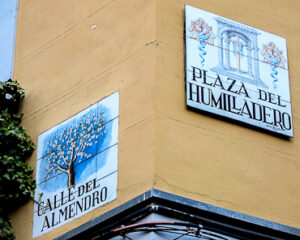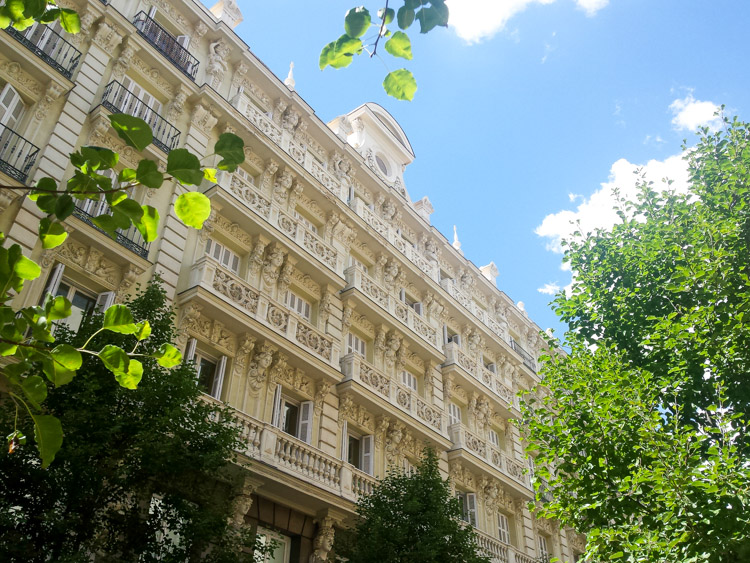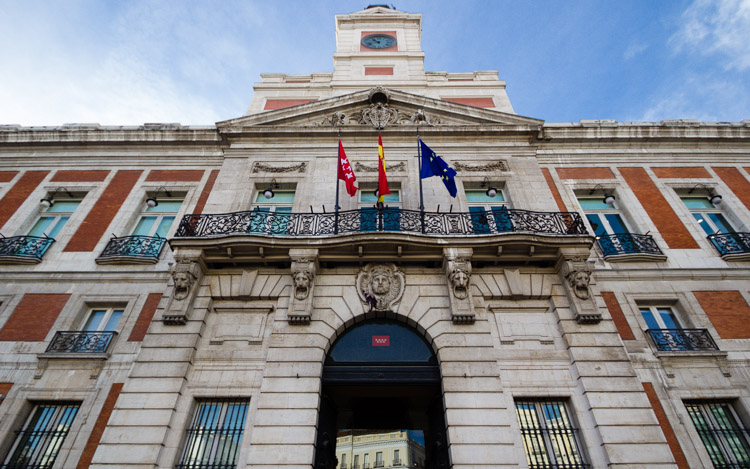
The street names in Madrid have almost always an historical explanation, sometimes based on real history, but also sometimes based on legends.
Witch are the most famous streets to visit in Madrid?
If you want to visit Madrid, those are some streets that you can’t miss, for sightseeing, shopping and eating.
Prado, Recoletos and Castellana Boulevard
Those 3 boulevards are the main connection between the North and the South of Madrid. Castellana boulevard in the north has the Real Madrid Stadium and the financial district. Recoletos boulevard in the middle has the Archaeological Museum. And Prado boulevard is the best for a sightseeing stroll: check this post with all the monuments you can see in the Prado Boulevard.
Alcala street
Alcala is the longest street in Madrid, the intersections with Gran Via and Prado are beautiful, specially with the Palace of Comunications. It is also famous for its 18th century gate, the ‘Alcala Gate‘.
Gran Vía boulevard
One of the favorites boulevards among locals, during the day is perfect for shopping, during the night great for its many theaters and rooftops with views. Check this article with lost of information on what to do in Gran Via.
Mayor street
It connects the Cathedral with Puerta del Sol and Plaza Mayor, it has lots of souvenir shops, many restaurants (but mostly touristy ones), shoes stores (usually good quality, leather, and made in Spain). This street has many beautiful buildings, and you will also came across with the beautiful Plaza de la Villa and the San Miguel Market.
Preciados street
One of the most popular streets in Spain for shopping, mainly for clothes and shoes. extremely crowded during sales and Christmas shopping!
Fuencarral street
This is a pedestrian street, great for a stroll, and the main street in the trendy neighborhood of Chueca.
Arenal street
Pedestrian street that connects the Royal Palace with puerta del Sol. Check this post on what to see in Arenal street.
Huertas street
This is the main street in the trendy neigborhood Barrio de las letras, known by locals to be one of the best areas for restaurants in Madrid.
Historical explanations for some of the streets names
Nowadays when a new street is built it always as a name assigned, usually commemorating someone or something. But it was not always like this, in the past most people couldn’t read, so streets didn’t have names. People just had to explain where they lived, like for example “I live in the street of the lemon tree”, or “I live in the street of the Sword makers”.
Eventually those explanations became the oficial names of those streets.This is why in Madrid, for example, many streets have guilds names.
Puerta del Sol (Gate of the Sun)
16th century was the time when the uprising against Emperor Carlos V started in Castilla. At that time Madrid wasn’t the capital of kingdom yet (it later became the capital in 1561) but rebels built there a watchtower or a small castle to defend themselves. The watchtower’s main door was facing east, from where they would witness the sunrise each morning. This is just one theory though, history in this case is not completely reliable. You can read another possible explanation here, and some fun facts about Puerta del Sol.
Calle Carretas (Carts street)
It is said that, in order to defend the watchtower of the Puerta del Sol, the rebels used carts to build a barricade. This street (along with Montera), were the first streets in Madrid that had sidewalks in 1834.
Plaza del Humilladero (Wayside Cross Square)
A wayside cross or humilladero is a place used by visitors to ‘humble’ themselves (by bowing) to show their religious devotion in front of the cross or niche. These crosses were typically found near the entrances or exits of towns, and some even remain to this day.
Calle del León (Street of the Lion)
Legend has is that there was a lion on this street. The owner of one palace here used to allow visitors to see the lion, for a small fee. It was a very unique ‘zoo’ in the centre of Madrid.
This street was also known for its Mentidero (a place where people used to gather and gossip) and performing comedians. Cervantes was also a brief resident in this neighborhood, living in a house on the corner of another street that is nowadays called Lope de Vega. Today this street is known for having Real Academia de la Historia (Royal Academy of History) which was founded in 18th century.
Calle de la Pasa (Street of the Raisins)
“Calle de la Pasa, quien no pasa no se casa” is a Spanish proverb: “The street of Pasa; the one who doesn’t cross it, doesn’t get married”. This saying is popular because of the vicarage that was situated on this street (number 3) where marriages used to be compulsorily registered. And back to the origins of the name, the bishops from the vicarage were known to hand out raisins to beggars!
Plaza de Santa Ana (Saint Anne Square)
Today this square is known by its terraces and tapas, but many years ago it was where Convento de Santa Ana (Convent of Saint Anne) was located. Jose Bonaparte, Brother of Napoleon, who ruled Spain for a short period of time, decided to demolish convents and buildings in order make room for more squares and open spaces.
Segovia Street, Toledo Street and Alcalá Street
Those streets were the main access roads to Madrid from these main cities: Segovia, Toledo and Alcalá, through Segovia Bridge, Toledo Bridge and Puerta de Alcalá (Alcalá Gate).
The ‘story telling’ street plaques
Walking through the historical streets of Madrid you may have noticed that many of them have beautiful ceramics. They were designed by Alfredo Ruiz de Luna in the 90s, and the illustrate the story behind the origins of the street name.
We have explained some of them, now here is a selection of photos:
BIBLIOGRAPHY
- Los Nombres de las calles de Madrid – Mª Isabel Gea Ortigas
- Hidden Madrid – Mark & Peter Besas
- Atlas Ilustrado de la Historia de Madrid – Pedro López Carcelen



0 Comments